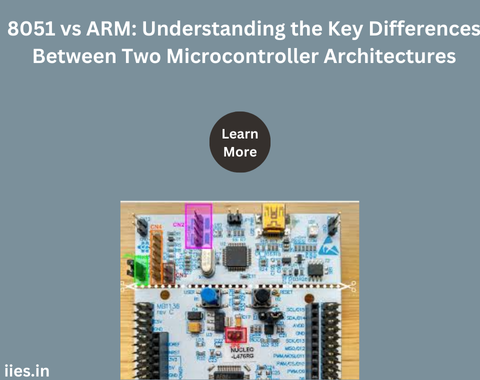
Microcontrollers form the backbone of countless electronic systems, from consumer electronics to industrial automation. They provide the core functionality needed to control various devices and manage processes. Two of the most widely recognized microcontroller families are the 8051 and ARM architectures. Although both serve similar purposes, they come from distinct eras of development and are suited for different applications. In this article, we’ll explore the 8051 microcontroller, investigate its core features, and examine whether it belongs to the ARM family.
The 8051 microcontroller, developed by Intel in 1980, is an 8-bit microcontroller that became one of the most popular choices for embedded systems for several decades. Its widespread adoption was due to its simplicity, reliability, and robust set of features that made it an ideal choice for early embedded systems.
Some of the key features of the 8051 microcontroller include:
The 8051 was widely used in applications such as consumer electronics, automotive systems, industrial automation, and home appliances. Its simplicity made it easy to program and integrate, and numerous manufacturers produced variants of the 8051, ensuring its continued relevance long after its initial introduction.
ARM (Advanced RISC Machines) microcontrollers, on the other hand, are a more modern family of microcontrollers that are based on the Reduced Instruction Set Computing (RISC) architecture. ARM Holdings licenses its processor designs to various manufacturers, including well-known companies like STMicroelectronics, NXP, Texas Instruments, and many more.
ARM microcontrollers are known for their efficiency, flexibility, and powerful processing capabilities. Some of the main characteristics of ARM microcontrollers include:
ARM microcontrollers are used in a wide range of applications, from smartphones and tablets to IoT devices, wearable technology, and industrial automation.
Although both the 8051 and ARM microcontrollers are designed for embedded systems, there are significant differences between the two. These differences make each suitable for different types of applications and use cases.
Bit Width and Processing Power:
The 8051 is an 8-bit microcontroller, meaning it processes 8 bits of data in a single cycle. In contrast, ARM microcontrollers are typically 32-bit or 64-bit, allowing them to process larger amounts of data at once. This gives ARM microcontrollers a significant edge in terms of processing power and speed. Applications that require complex computations or high-speed data processing, such as multimedia devices or real-time control systems, are better suited for ARM-based microcontrollers.
Instruction Set Architecture:
The 8051 uses a Complex Instruction Set Computing (CISC) architecture, which has a larger set of instructions, some of which can be more complex and take multiple cycles to execute. On the other hand, ARM microcontrollers use RISC architecture, which has a reduced number of simpler instructions that can be executed quickly. The RISC architecture allows ARM processors to achieve higher performance while consuming less power, which is critical for modern portable and battery-powered devices.
Power Consumption:
ARM microcontrollers are designed with power efficiency in mind, making them suitable for applications that need to operate on limited power sources, such as battery-powered devices. The 8051, while efficient for its time, does not offer the same level of power optimization as modern ARM-based microcontrollers. Power management features like sleep modes and dynamic frequency scaling, which are common in ARM processors, help reduce overall energy consumption.
Memory and Storage:
The original 8051 microcontroller had limited memory resources, with 4 KB of ROM and 128 bytes of RAM. While modern variants of the 8051 have increased memory capacity, they still fall short of the memory capabilities of ARM microcontrollers. ARM microcontrollers can handle much larger memory sizes, which allows for the execution of more complex programs and the storage of larger datasets. This is essential for modern applications that require real-time data processing, such as image recognition, AI, and machine learning.
Flexibility and Customization:
ARM microcontrollers offer a wide range of customization options, thanks to the modular nature of the ARM architecture. Manufacturers can license ARM cores and add their own peripherals, memory configurations, and other features, resulting in a diverse array of ARM-based products. This makes ARM microcontrollers highly flexible and adaptable to various application needs. The 8051, while versatile, does not offer the same level of flexibility in terms of peripheral integration and memory configurations.
Development Ecosystem and Support:
ARM microcontrollers benefit from a large, active development community and a vast ecosystem of development tools, software libraries, and operating systems. ARM Cortex-M microcontrollers, in particular, have a wide range of development tools, both open-source and commercial, that make development easier. The 8051, while still supported by many manufacturers, has a smaller development ecosystem compared to ARM.
No, the 8051 is not an ARM microcontroller. The 8051 and ARM microcontrollers belong to two distinct families of processors with different architectures, design philosophies, and use cases. The 8051 is an 8-bit microcontroller developed in the 1980s, while ARM microcontrollers are based on the more modern 32-bit or 64-bit RISC architecture.
While the 8051 microcontroller still finds use in certain low-cost, simple embedded applications, ARM microcontrollers have become the dominant choice for modern embedded systems due to their superior performance, power efficiency, and flexibility. Understanding the key differences between these two architectures is essential for selecting the right microcontroller for a given application.
Indian Institute of Embedded Systems – IIES